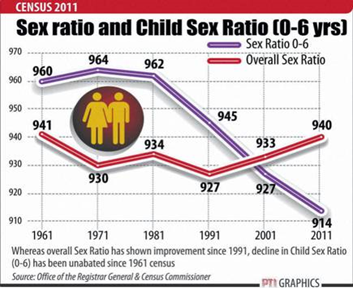India’s population is expected to be more feminine in 2036
-
Context:
- The country’s sex ratio of the total population (females per 1000 males) is expected to increase from 943 in 2011 to 957 during 2036.
-
Background:
- India’s population is expected to be more feminine and hold better future for women after 15 years from now, indicated the population projections made by the National Commission on Population under Ministry of Health and Family Welfare.
- The report of the technical group on population projections titled population projections for India and States 2011 – 2036 has observed that the population in 2036 is expected to be more feminine compared to the population as of 2011 when it came to sex ratio.
- It is observed that in 2036 sex ratio in eighteen states, except Kerala, Karnataka, Maharashtra and Gujarat will increase as compared to 2011," the report said adding that the lowest sex ratio of 899 is expected to be in NCT of Delhi in 2036, followed by 900 and 908 in Gujarat and Haryana respectively.
- Infant mortality rate (IMR): The report said that the infant mortality rate (IMR) of the country, which is reported to be 46 in 2010 is expected to go down to 30 by the end of the period 2031-35. The IMR is expected to decline in all the states during 2011-35. The IMR, which was highest in Madhya Pradesh at 58 followed by 57 in Uttar Pradesh in 2011-15 is expected to come down to 37 in Madhya Pradesh, followed by Uttar Pradesh (38) in 2031-35, the report said.
- Other states, where IMRs are expected to be in the range of 30-40 during 2031-35 are Rajasthan, Assam, Odisha, Chhattisgarh, Madhya Pradesh and Uttar Pradesh. The lowest IMR is expected to be in Kerala at 9 in 2031-35. It will be followed by Tamil Nadu with IMR declining from 22 in 2011-15 to 16 during 2031-35, the report said indicating that lesser women will be losing their children.
- Total Fertility Rate (TFR): The report also said that the Total Fertility Rate (TFR) is expected to decline from 2.34 during 2011-2015 to 1.72 during 2031- 35. The assumption is that the Total Fertility Rate (TFR) would follow the recent pace of decline.
- Reasons: Over the decades, efforts made by the government have adopted a multi-pronged strategy to promote the value of the girl child, not just through schemes and programmes, such as Beti Bachao Beti Padhao, but awareness generation to build a positive environment for women and girls.
-
What is the Sex ratio in India:

Reasons for declination of sex ratio:

-
What are the Measures taken to improve sex ratio in India
- Government has adopted a multi-pronged strategy entailing schemes, programmes, and awareness generation/advocacy measures, to build a positive environment to save and protect the girl child through gender sensitive policies, provision and legislation.
- Further, under the National Rural Health Mission (NRHM) and within its umbrella the Reproductive and Child Health Programme, many interventions have been launched to improve sex ratio.
- For prohibition of sex selection, before and after conception, and for regulation of prenatal diagnostic techniques, the Government has enacted a comprehensive legislation, the Pre-conception and Pre-Natal Diagnostic Techniques (Prohibition of Sex Selection) Act in 1994. It was further amended in 2003.
- The National Inspection and Monitoring Committee (NIMC) have been reconstituted and inspections of ultrasound diagnostic facilities have been intensified.
- States have been advised to focus on Districts/Blocks/Villages with low Child Sex Ratio to ascertain the causes, plan appropriate Behaviour Change Communication campaigns and effectively implement provisions of the PC & PNDT Act.
- Religious leaders, women achievers etc. are being involved in the campaign against skewed child sex ratio and discrimination of the girl child.
- Beti Bacho Beti Padhao (BBBP) to improve the Child Sex Ratio and enabling education for the girl children.
Conclusion:
Although the report suggests that India’s population is expected to be more feminine and hold better future for women but the target is yet to achieve. To correct the persistence in adverse sex ratio, the need is to change the mindset and attitudes of people, especially young adults.The war against female foeticide, infanticide and girl child discrimination can be won only if we start this war from our own home. Once we are awake, girls are safe.

